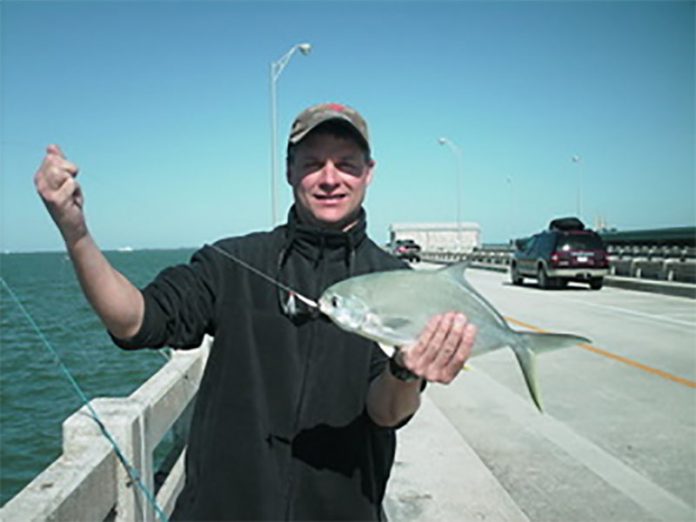The holiday season seemed to arrive a bit early at the Sunshine Skyway Fishing Piers as many visiting anglers were gifted with some of the finest grouper fishing you could imagine from a land-based fishery. Gag grouper were both large & aggressive this past week and many fish in the 30″ plus range hit the concrete at the piers. Gags were not the only reef-dwellers being placed in coolers, as porgies, snapper and grunts were also feeding well. Spanish mackerel & bluefish provided some action over the past week, with anglers willing to move along each pier (and from pier to pier) having the most success. Ladyfish were feeding heavily along the approach sections after dark – much to the delight of visitors who enjoy making fish patties with this acrobatic species! Blacktip, sharpnose and bonnethead sharks provided action for customers seeking action from these toothy critters.
Gag grouper were excellent this past week and many fish in the 30″ class (and above) were landed at the piers. The most successful method was free-lining pinfish, pigfish or small jacks out to the artificial reefs, but other methods were productive as well. Free-lining live baits is perhaps the easiest way to connect with gags at the piers because the terminal tackle end of this business is so simple. All that is needed is mainline in the 50 lb. class, leader material in the 80 lb. class and a stout hook in the 7/0 – 10/0 range (depending upon the bait size). Medium-heavy conventional or spinning gear will both work fine for free-lining, but conventional reels that automatically engage on a handle turn and/or spinning tackle with a bait-runner feature is helpful.
Procuring bait for gags at the piers is quite easy – even for beginners new to the pier fishing scene. Use sabiki-style baitfish rigs in the larger classes (like size #4 or #6) and tip the hooks with a bit of squid or shrimp. Simply bounce the rig along the bottom to catch plenty of pinfish & pigfish so common at the Skyway Piers. Anglers wondering how to keep live baits down towards the reef without any weight have learned to hook them near the anal fin in order to elicit a downward-swimming response from the bait. Two other fishing methods took big gags this past week – plugging and bottom rigging. Casting a live or dead bait near the artificial reefs and holding bottom with a 2 oz. – 4 oz. egg sinker can be quite productive at the piers and was indeed so this past week. The rod is usually placed in a rod holder while awaiting a bite. Cranking diving plugs over the reefs was also a good tactical choice, and some successful grouper diggers employed several methods at once to increase their odds.
Ladyfish were blasting the surface after sundown along the approach sections (between the tollbooth & dumpsters) on each pier. Visitors were having great fun throwing top water plugs to these fish, and even managed a few bluefish as bycatch. Perhaps the most productive method was the one that works so well for Spanish mackerel at the piers – deploying cut strip or belly baits of sardine or herring on a long shank hook with a split-shot sinker added for depth. Many visitors inquire about the edibility of ladyfish, and the (seemingly unanticipated) answer is that they are excellent when prepared correctly. Somewhat similar to the skeletal structure of a freshwater northern pike, ladyfish have bones that run from the backbone out to their lateral line. Place these fish in the freezer for about an hour, fillet down the entire size, and use a spoon to scrape the white flesh from the skin. The bones will come out and you will be left with succulent white meat perfect for mixing with bread crumbs and your favorite seasoning before being deep fried. Dip in your favorite sauce and you will have an entirely different outlook on this species.
Numbers of smaller sharpnose and bonnethead sharks surprised anglers soaking shrimp or cut bait on light wire leaders this past week. Indeed, even a few jumping blacktips got into the mix, but they seemed outnumbered by the other species. Bonnethead sharks are primarily crustacean-feeders, but they will occasionally take fish species as bait. Bonnets are easy to identify because they look like a hammerhead with a rounded nose and often cruise the surface like their larger brethren. Sharpnose sharks like smaller cut baits and are fairly easy to identify because they have white spots along their skin. All of the smaller shark species found at the piers are great fun on light tackle and can be easily handled with outfits normally used for freshwater bass & catfish.
- The Skyway, Paul Bristow - August 24, 2018
- The Skyway, Paul Bristow - August 17, 2018
- The Skyway, Paul Bristow - August 10, 2018











